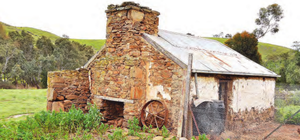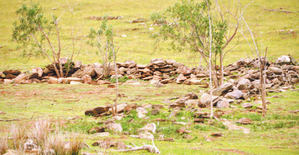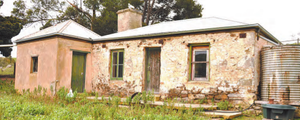Town on edge of oblivion - Anyone heard of Staughton?
The Courier - Wednesday, 2 September 2015 by Melissa Keogh
 Only three buildings remain of what was once a thriving village called Straughton near Callington.
Only three buildings remain of what was once a thriving village called Straughton near Callington.
The town of Staughton, nestled on the banks of Dawesley Creek near Callington, was once home to 100 Cornish miners and their families and boasted more than 30 homes as well as a post office, school, cemetery and church. Today all that remains are three ruins and a few scattered piles of stones. Time, it seems, is marching on and allowing a part of SA’s history to slip into oblivion.
 This one room cottage would have housed a whole mining family in the 1840'sThe 175-year-old settlement didn’t exist according to most modern maps. Google has never heard of it and few locals are aware of its existence.
This one room cottage would have housed a whole mining family in the 1840'sThe 175-year-old settlement didn’t exist according to most modern maps. Google has never heard of it and few locals are aware of its existence.
The village, which was inhabited from 1840 to 1870, is now home to Peter and Kathy Schneider who have a dream of ensuring Staughton’s place in SA’s history is not forgotten.
“When we say we live at Staughton, people – even locals – always say they have never heard of it,” Mrs Schneider said. “It’s absolutely forgotten. “Now it’s the ghost of a mining village that hardly anyone knows about and I think that’s special.”
Staughton, located on the Eclair Mine Road not far from the freeway and about 5km from Callington, was established in the early 1840s, when production of copper began in Kanmantoo.
 Kathy Schneider stands in the doorway of the cottage built about 175 years ago, its interior riddled with bullet holes.The village’s pioneer, William Giles, named it Staughton, after an English settlement of which he was fond.
Kathy Schneider stands in the doorway of the cottage built about 175 years ago, its interior riddled with bullet holes.The village’s pioneer, William Giles, named it Staughton, after an English settlement of which he was fond.
More miners soon arrived and by 1845 Staughton had enough inhabitants for the Primitive Methodist Church to be built in 1846. “The miners would’ve lived in Staughton and walked to the Kanmantoo Copper Mine – back when they were just digging holes in the ground,” Mr Schneider said.
A school was established in 1853 and attendances averaged around 30 students.
Unpleasant story
Mrs Schneider – a self confessed dreamer and artist who paints while overlooking the cottage ruins – said although she held no solid beliefs in the afterlife, she “felt a presence”. “Often in the afternoon the whole valley goes into a mist and you feel spiritual in a way,” she said.
“I know of one unpleasant story, but it’s all a bit vague.” - A teenage girl vanished from Staughton in about 1864 after setting off to fetch some calves. She was never seen alive again. Soon after her disappearance a local man left the area for Adelaide and one  Staughton’s cemetery is identifiable by a crumbled stone wall, built by William Venning. Although no headstones are present, it is believed many bodies were laid to rest following a scarlet fever and diptheria epidemic in 1864.night drunkenly blabbed about the girl’s murderous fate. Her bones were discovered 25 years later by a farmer on a property south of Kanmantoo.
Staughton’s cemetery is identifiable by a crumbled stone wall, built by William Venning. Although no headstones are present, it is believed many bodies were laid to rest following a scarlet fever and diptheria epidemic in 1864.night drunkenly blabbed about the girl’s murderous fate. Her bones were discovered 25 years later by a farmer on a property south of Kanmantoo.
That year an outbreak of scarlet fever hit Staughton, followed by diphtheria and the residents began to drop like flies. A cemetery was established but today all that remains are several scattered rock piles from the stone wall. “There are no headstones present, but unless they’ve been exhumed, we believe there are still people buried in the cemetery,” Mrs Schneider said.
By the 1860s Staughton’s days were numbered, as the nation was in the height of the gold rush and miners sought better, more prosperous lives in new mining towns. The walls and roofs of the home began to collapse as the families moved on. By WW1 the area was solely grazing land and Staughton passed through the hands of few owners, one being ‘Mr Brown’ who lived in one of the cottages until 1950.
 This five-room cottage is believed to have once been the town’s post office and was later used by the land’s owner as a residence until the 1950s.In 2000 the Schneiders were itching to escape Adelaide suburbia and, after reading a newspaper advertisement for an isolated piece of real estate, they decided to “go for a drive”. “We were coming down the hill and I saw the cottage and I thought ‘this is it’,” Mrs Schneider said. “We just fell in love with it and knew we were going to be here no matter what the problems were.”
This five-room cottage is believed to have once been the town’s post office and was later used by the land’s owner as a residence until the 1950s.In 2000 the Schneiders were itching to escape Adelaide suburbia and, after reading a newspaper advertisement for an isolated piece of real estate, they decided to “go for a drive”. “We were coming down the hill and I saw the cottage and I thought ‘this is it’,” Mrs Schneider said. “We just fell in love with it and knew we were going to be here no matter what the problems were.”
The couple has left the property mostly untouched, except for a new home they built overlooking the valley, and a number of trees have been planted.
“The history of the place wasn’t explained to us when we first bought it,” Mrs Schneider said. “We just liked what we saw and then afterwards I went around with an aerial map and worked out that 35 dwellings of some sort had existed on the land.”
The Schneiders said they hoped the lonely village would one day be set back on the map. The pair hold dreams for future artist retreats, guided walks, tours and overnight accommodation at the property.
“When we came here we felt like pioneers,” Mrs Schneider said.


